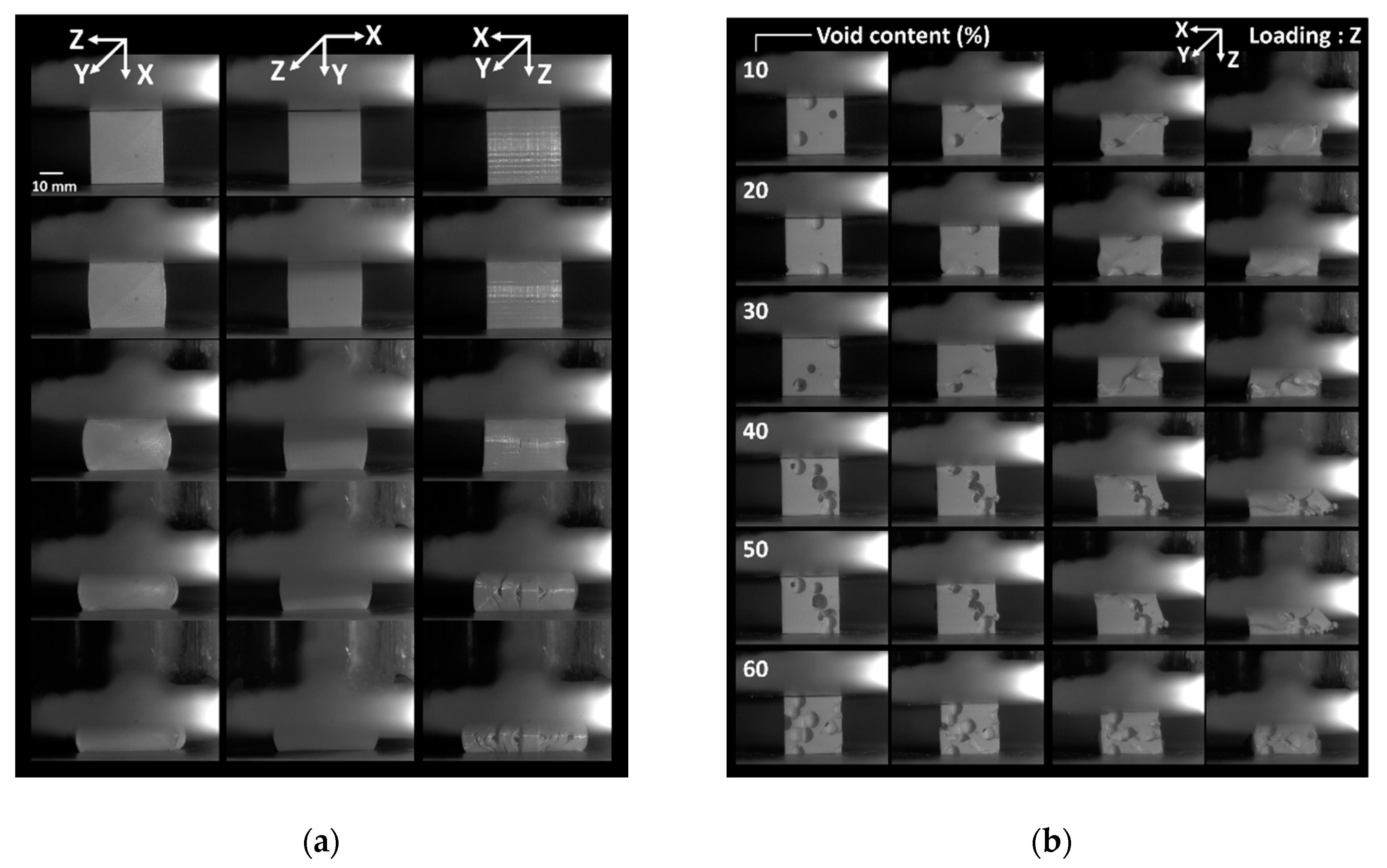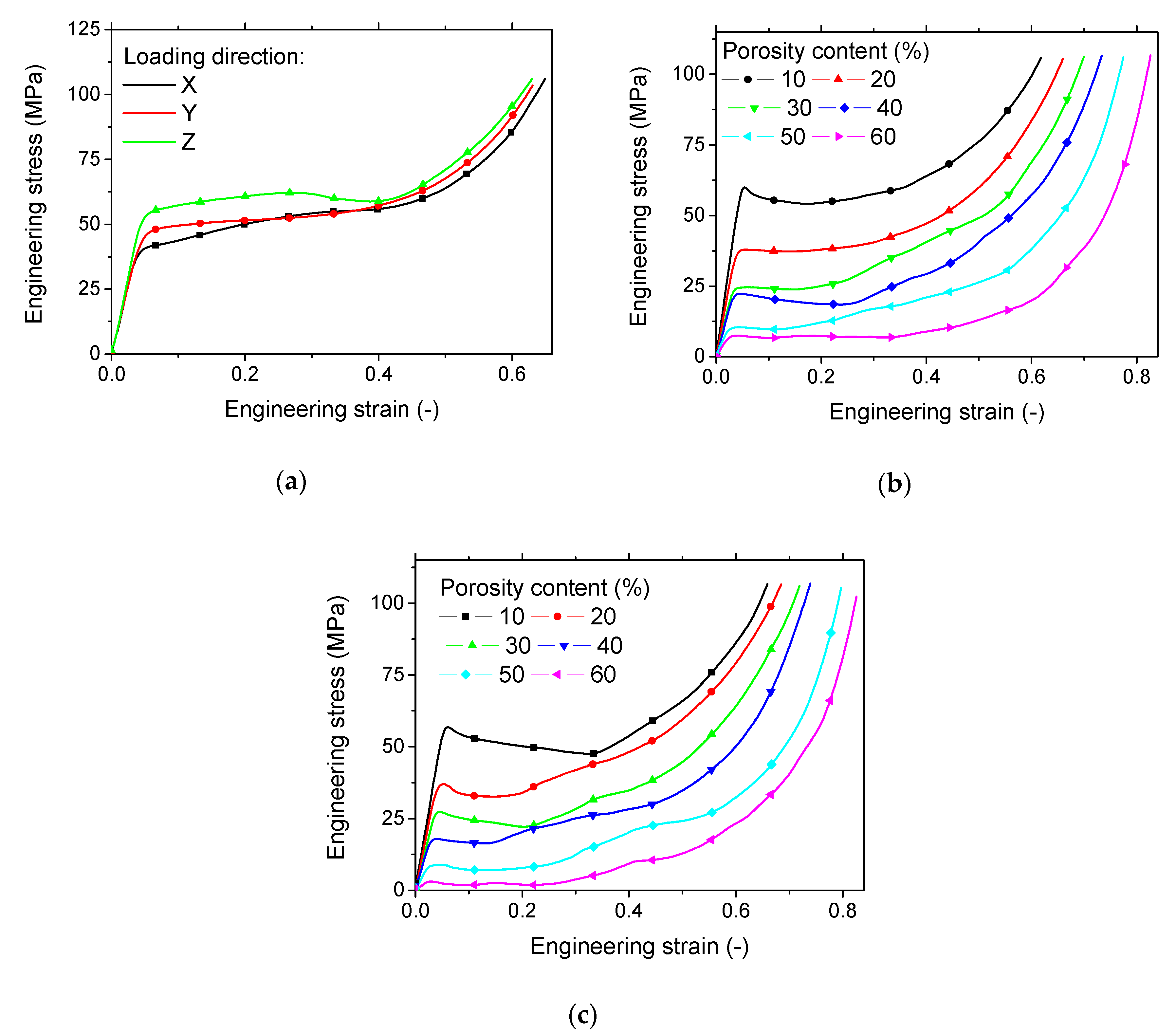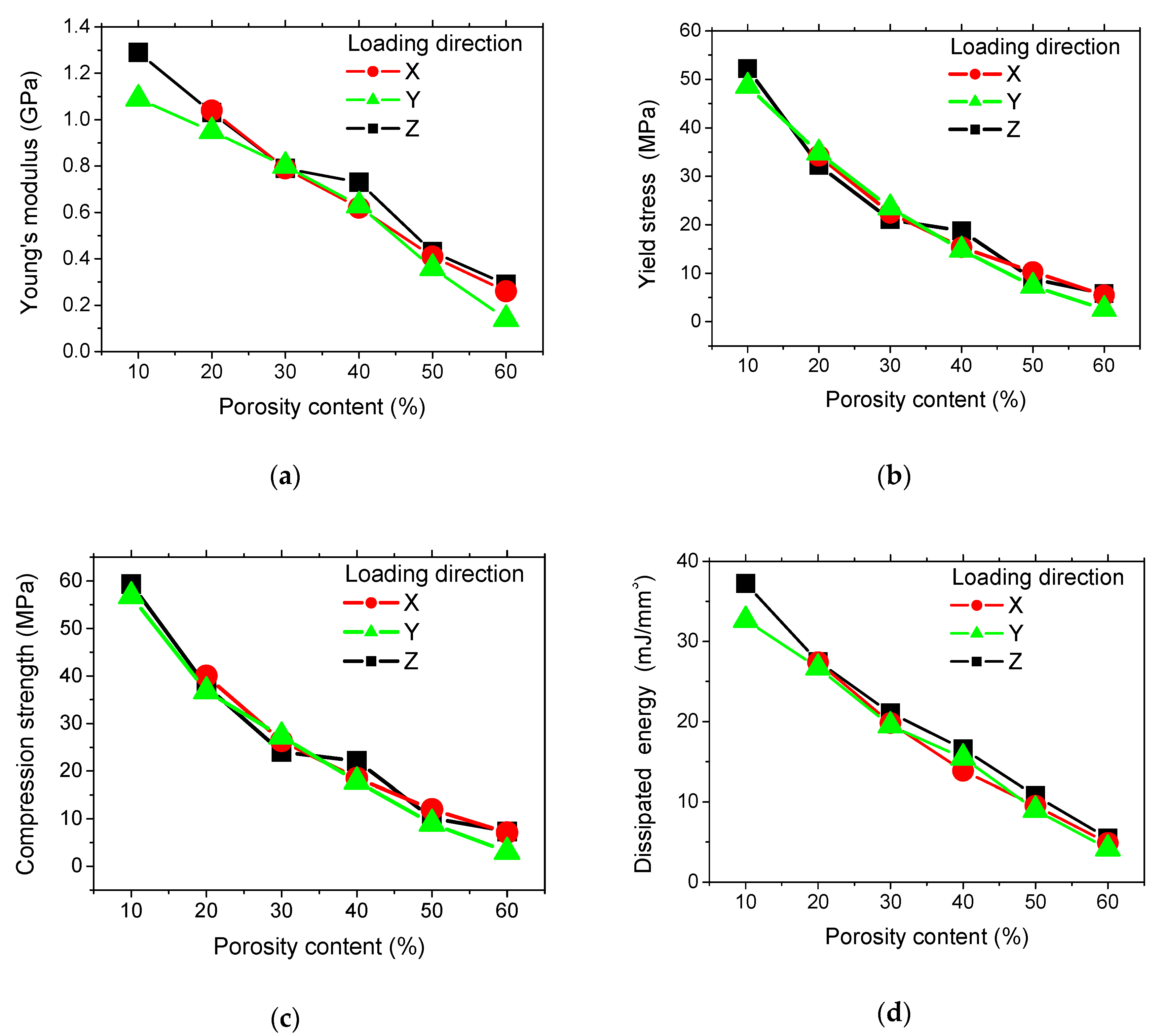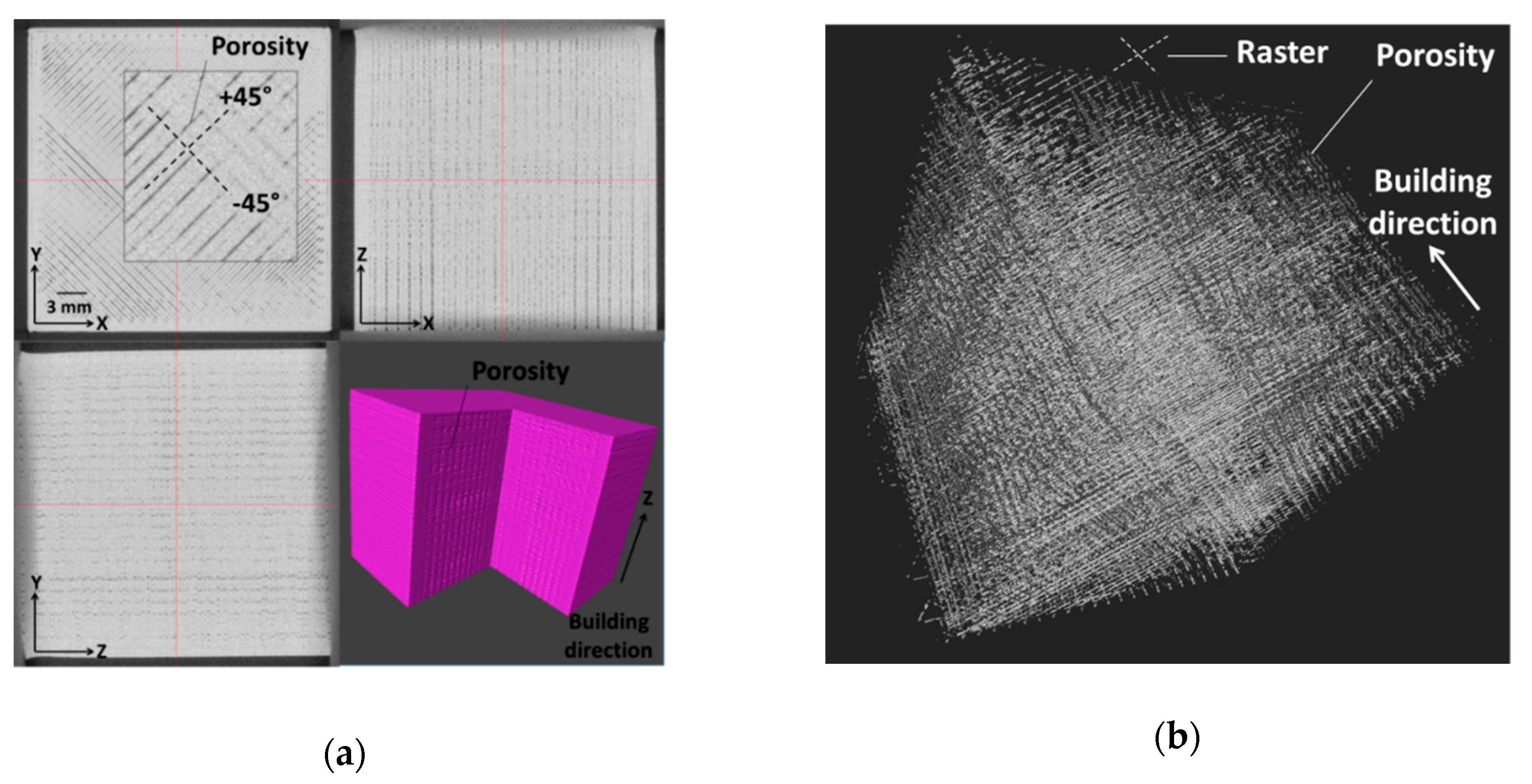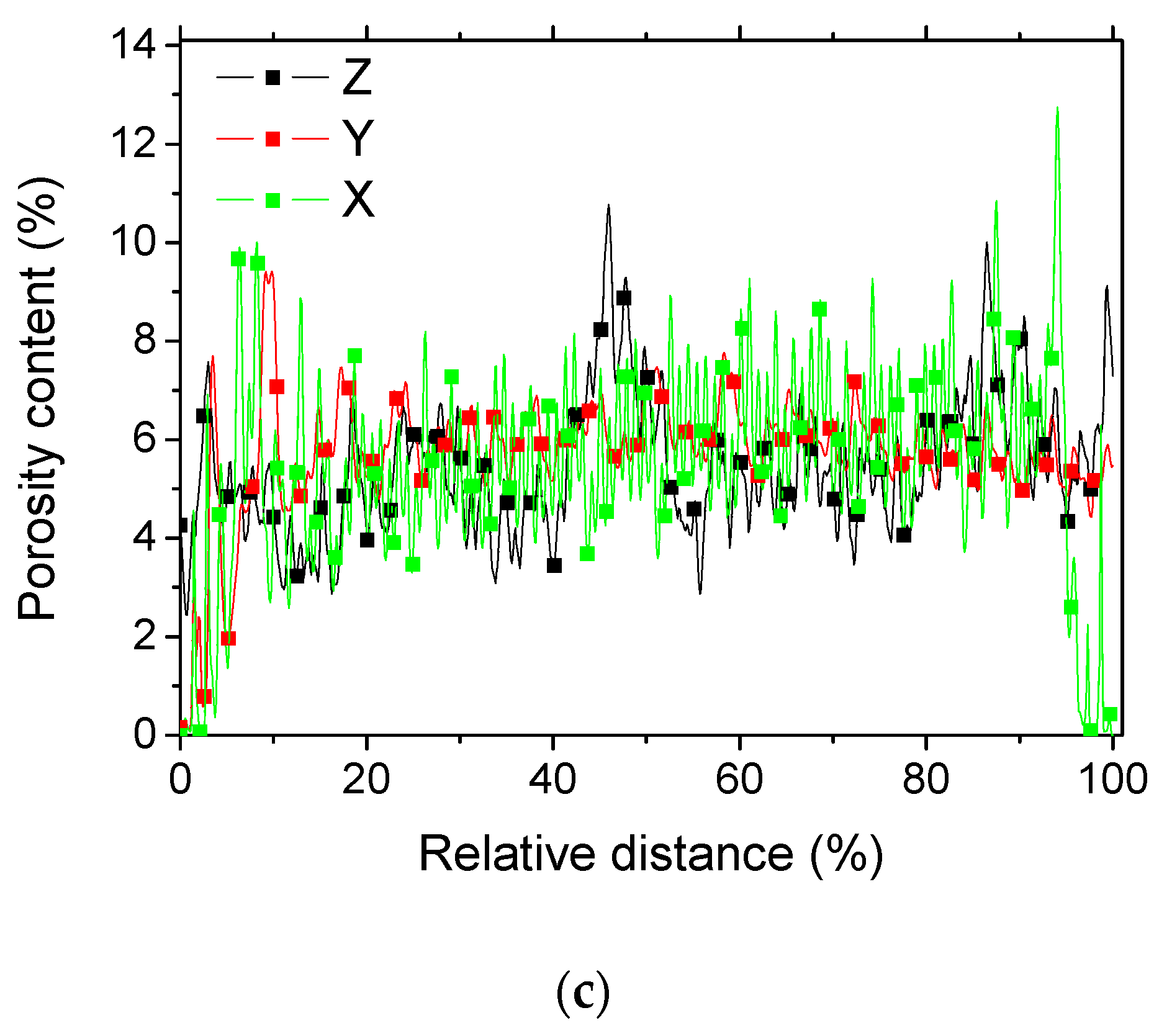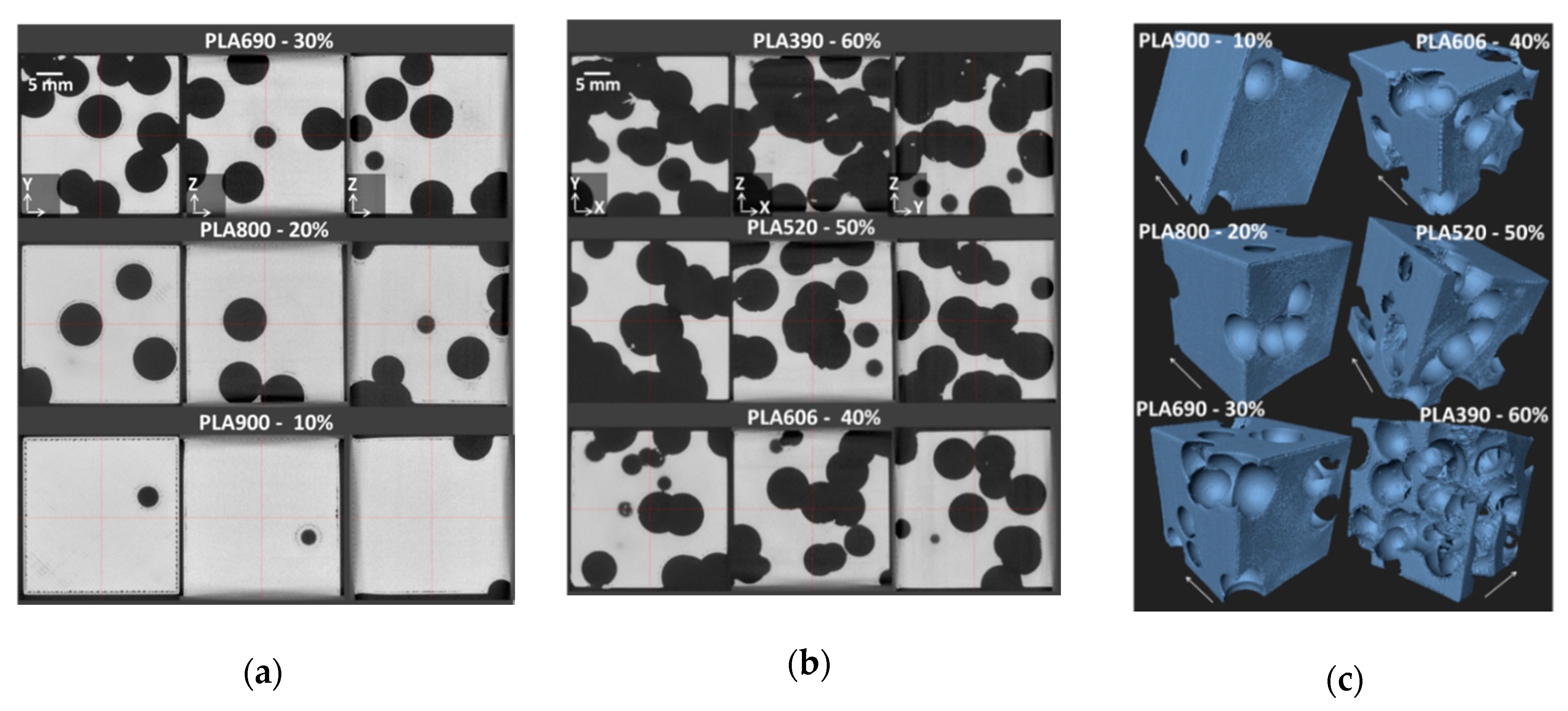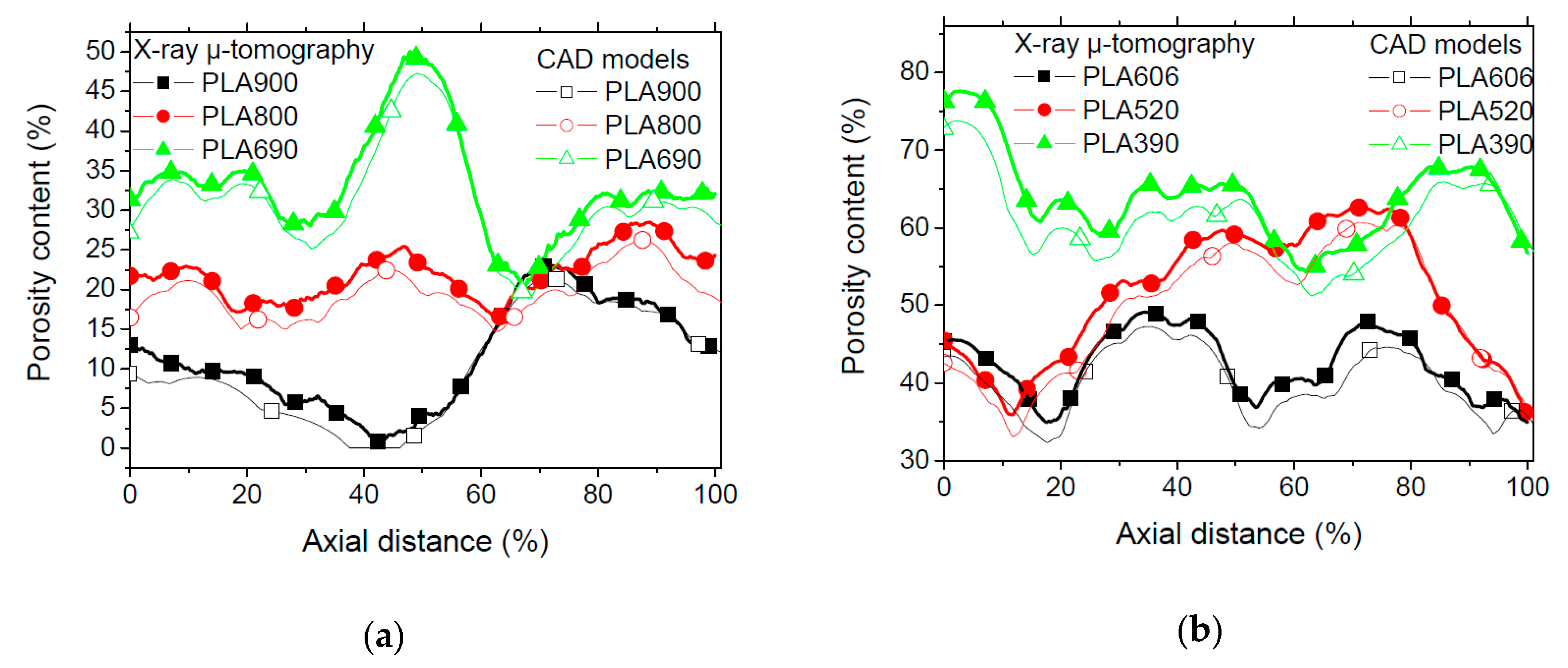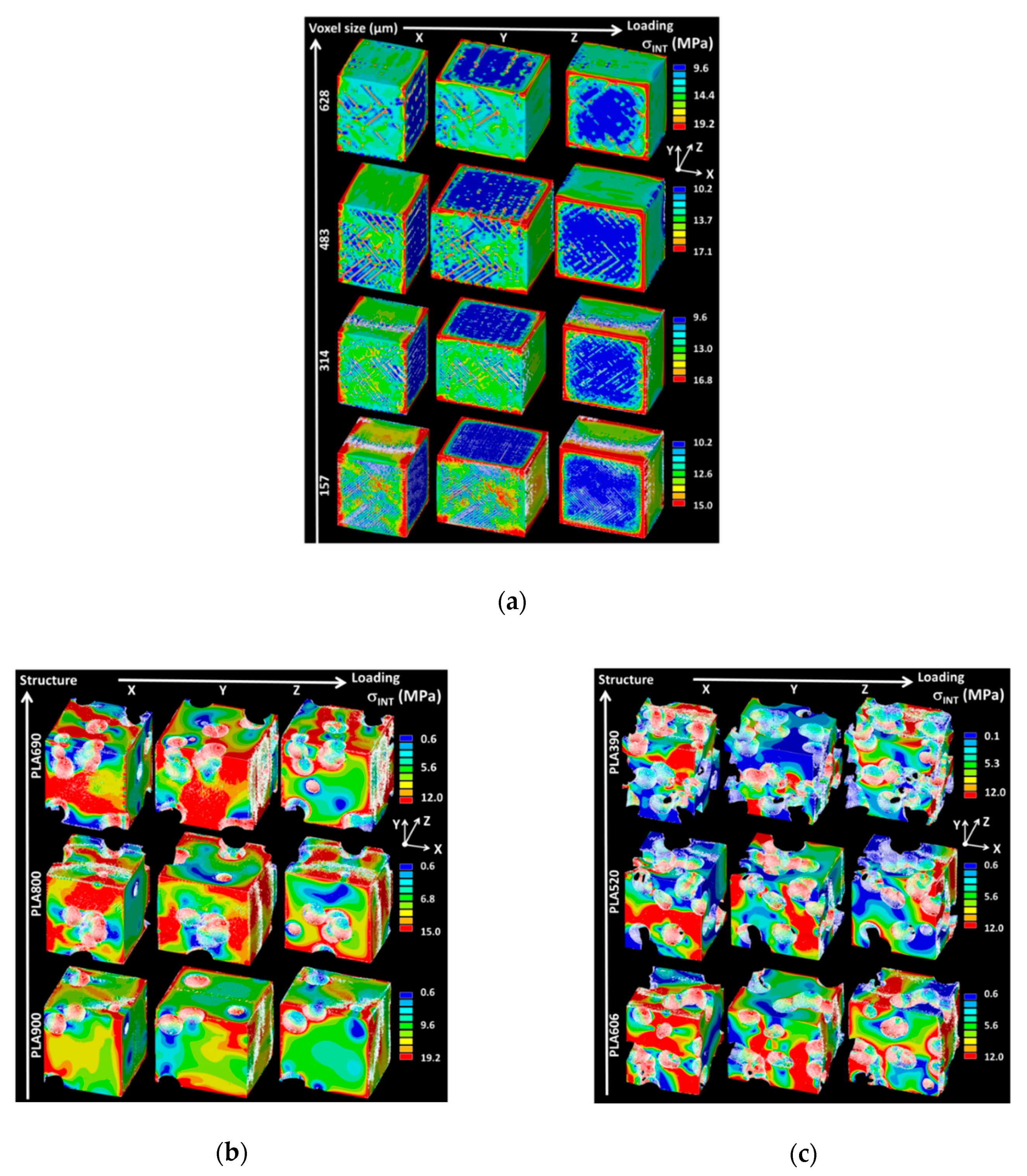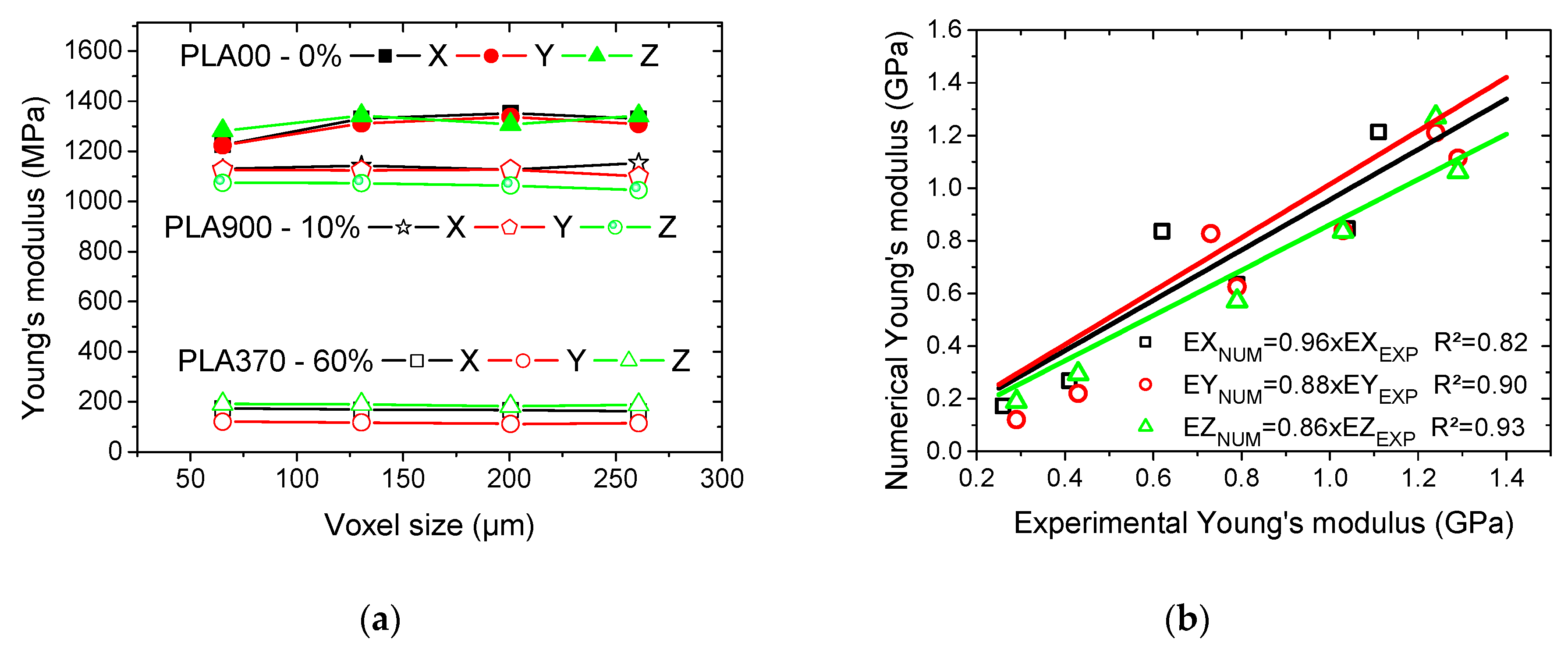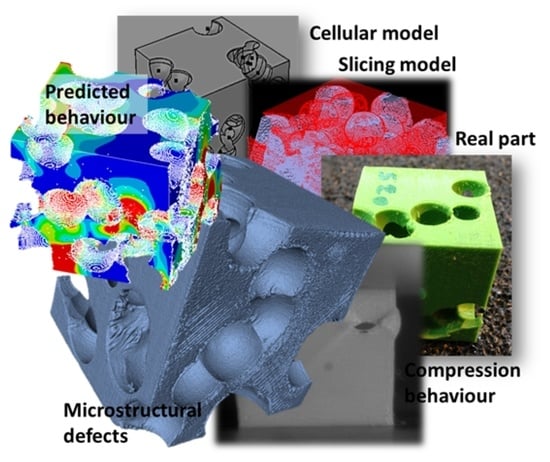4.1. Microstructure and Mechanical Results
Figure 1a depicts the typical compression behaviour of full dense PLA cubes that were manufactured using FDM in all loading directions.
The in-plane deformation sequences in the X and Y directions well demonstrate the resistance of the printed PLA against damage development within the plane of construction, despite the severe load levels. A former study on ABS conducted by Guessasma et al. [
11] showed that Poisson’s expansion leads to the emergence of shear bands within plane of construction, which attests that damage growth is possible, even under compression loading [
11]. The main deformation mechanism associates the positive strain levels at lateral faces to the process-induced porosities, which are found to connect by pore opening. The present case refers exactly to the same printing conditions (printing angle of 0° promoting filament crossing in a sequence −45°/45°). The deformation sequence for a loading in Z-direction (i.e., building direction) shows tendencies to filament decohesion more evident in this case as compared to the in-plane response. To find out more about the compression behaviour in the case of intended porosity, the deformation sequences for cellular structures containing from 10% up to 60% of intended porosities are shown in
Figure 1b.
Despite this similar configuration, the pore opening is inconclusive, even at large load levels. For a loading in the building direction (
Figure 1b), there is evidence of ductile behaviour of the printed cellular structures with typical three stages of deformation. The main ones are the cell collapse and densification. There is no significant influence of the raster identified from the deformation sequences. The only minor feature that was observed from the examination of deformed structures in the presence of transverse cracks that develop by a mechanism of crack opening within the plane of construction (see, for instance, the sequences for cellular structures with 40% and 50% of intended porosities). The deformation sequences in the lateral directions (
Figure 2 shows examples of loading in Y-direction) clearly depict the presence of vertical cracks.
These correspond to inter-layer delamination involving the building direction. Indeed, the presence of intended porosities generates a stress concentration around the pore and, because of the relatively weak cohesion in the building directions, cracks are likely to depart from the porosity and runs in the vertical direction (normal to the building direction) by a mechanism of crack opening. This mechanism is possible because of the Poisson’s expansion.
In terms of load response,
Figure 2 compares the stress-strain curves that correspond to the deformation sequences in
Figure 1. Stress and strain values are expressed as engineering quantities.
The three stages of deformation of a ductile cellular material are depicted, even for the case of a fully dense PLA structure (
Figure 2a). The mechanical response is not similar for all deformation stages with the exception of the elastic stage. Indeed, the slope seems to be similar for all loading directions. The Young’s modulus obtained for the full dense PLA suggests that there is no mechanical anisotropy that is associated with the printing of PLA under the conducted printing conditions (
Table 1). The reason behind the similarity in elasticity behaviour relies on the amount of the porosity. This amount, if measured in all space directions, would show the same score. This would explain the minor difference of 8% in Young’s moduli measured in X, Y, and Z directions. A more elaborated discussion of porosity content is suggested in the next section.
The difference between Young’s moduli is less than 8%. For a further increase of the load level, the 3D printed PLA exhibits a superior trend in the building direction (Z-direction). The development of damage that is evidenced from the deformation sequence (
Figure 1a) corresponds to a decrease in the engineering stress for the engineering strain between 0.28 and 0.4. From the reading of yield stress and compression strength magnitudes in
Table 1, it can be stated that the good performance of the 3D printed PLA loaded in the building direction is obtained.
An improvement by 30% and 21% of these quantities is achieved with respect to the in-plane properties. This improvement is explained, from the processing viewpoint, by the small layer thickness used for building the printed PLA, which only represents 25% of the nozzle diameter.
Figure 2b,c compare the compression response of the printed PLA cellular structures for all intended porosity contents. In the loading direction, the trend ranking goes with the porosity amount. Low rankings in terms of elasticity, yielding, and strength are evidenced for large porosity contents. A positive effect of the intended porosity content on the width of the collapse plateau compensates the loss of performance with the increase of intended porosity content. The damage development within the cell collapse plateau depicted through the deformation sequences in
Figure 1b seems to have a limited effect on the cell collapse plateau. This effect identified as transverse cracking is to be related to the flatness of this deformation stage. However, the loading in the lateral direction Y (
Figure 2c) shows different compression responses. Indeed, within the second deformation stage, cell collapse is associated with significant decrease in the engineering stress, which is contrasted with the same deformation stage for a loading in the building direction (
Figure 2b). The development of vertical cracks due to the inter-layer delamination has a more significant effect on the compression response. This effect seems to be stronger when the intended porosity content is low, such as for 10%.
The quantification of the intended porosity content of 3D printed PLA cellular structures on extracted mechanical parameters, namely Young’s modulus, yield stress, compression strength, and mechanical energy, are depicted in
Figure 3 for all loading directions.
If we look at the first three mechanical parameters, there is no mechanical anisotropy identified from the loading in all directions if we exclude Young’s moduli measured at 10% of intended porosity. The fitting performed for all data shows the following linear trends
where
is Young’s modulus,
is yield stress,
is the compression strength, and
is the intended porosity content varied between 10% and 60%.
The correlation between the mechanical parameters of 3D printed cellular PLA and the intended porosity content suggests simple linear forms when compared to the exponential functions generally associated with the behaviour of typical cellular materials [
27]. In addition, the extrapolation of the mechanical properties for a full dense 3D printed PLA overestimates the magnitudes that were reported in
Table 2. This is due to the fact that process-induced porosity is neglected in expressions (1) to (3).
Figure 3d shows that the amount of dissipated energy during the compression loading is larger for a loading in Z-direction. This is true, especially when the amount of intended porosity is low.
The mechanical anisotropy can be considered to be low, even for the energy dissipation with regards to the relative small differences between loading directions.
The overall trend of energy dissipation, irrespective of the loading direction, is linear as in the previous cases
where
is the amount of dissipated mechanical energy that us associated with a compression by a 60% reduction in height.
In order to provide a microstructural interpretation of the mechanical results, X-ray micro-tomography images are exploited in the following.
Figure 4a shows cross-section and perspective views of the porosity that is induced by processing for a dense 3D printed PLA structure. A regular grid of micro-sized porosities is evidenced. From the cross-section views, the pore connectivity within the plane of construction (XY) follows the raster orientation by a sequence of −45°/+45°. Additionally, small porosities are identified between the raster and the external frame. These emerge as a consequence of the abrupt change in the printing nozzle trajectory during the laying down process. In the orthogonal planes XZ and YZ, pore connectivity in the building direction is also a main characteristic of the process-generated defects.
Table 1 shows the statistics conducted on the pore amount and connectivity. These data demonstrate the main characteristic feature of 3D printed materials using FDM, which is the formation of a highly connected regular network of micro-sized porosities, despite their small amount (
Figure 4b).
Previous data on ABS show that the pore connectivity, in this case, is small when compared to the massively connected pore networks of 85% reached for ABS [
28]. This difference is mainly due to the smaller ratio between the layer thickness and the nozzle diameter used in this study, which is four times in proportion lower than the one that was used for ABS.
Figure 4c displays the content profiles of the porosity induced by processing in the full dense 3D printed PLA. These profiles in the main three directions show two main features. The first one is the significant oscillation of the porosity content that indicates the regularity of pore spatial distribution in all directions. The second feature is the presence of characteristic peaks at endpoints in X-direction, which indicate the presence of porosity between the frame and the raster reaching more than 8%. The same peaks should be observed in Y-directions if the cropping wraps the entire sample width.
Figure 5a,b depict the cross-section views normal to X, Y, and Z directions for all PLA 3D printed cellular structures. These cross-section views show the relative absence of process-induced porosity, especially when the amount of intended porosity is large. For instance, minor micro-sized porosities that follow the raster orientation are found within the bulk for PLA900 and PLA800 corresponding to 10% and 20% of intended porosities (
Figure 5a). Additionally, porosities between the raster and the frame are also visible, especially for PLA900. In addition, defects near the intended porosities are also depicted.
These are created because of the strategy used to build the contour of the porosities themselves. These contours leave some space between the raster and the porosity frontiers. The process-induced porosities within the raster substantially decrease for PLA690, referring to 30% of intended porosities. However, some defects that are close to the external frame and at the intended porosities boundaries are still persistent. When a larger content of intended porosities is created in the 3D printed PLA matrix (
Figure 5b), the amount of defects vanishes, including the process-induced porosities and the defects at the boundaries.
Figure 5c illustrates the extent of defect through perspective views of all 3D printed PLA cellular structures. These cellular materials exhibit a cohesive structure and the laying generally featured in the building direction is absent. This is an additional proof of the beneficial role of a low layer thickness.
Figure 6 highlights the difference between the porosity profiles in order to evaluate the rendering of the 3D printed cellular structures with regards to the expectations from the CAD models. These porosity content profiles are plotted in the building directions. Both cellular structures with low (
Figure 6a) and large (
Figure 6b) contents of intended porosities depict the same minor difference between CAD models and 3D printed features.
This means that, under the printing conditions used in this study, an acceptable accuracy for printability of cellular PLA is obtained.
Table 1 shows that the overall porosity content of the cellular structures does not vary significantly from the intended one. The difference between the intended and measured porosity contents varies between 5% and 17%. The lowest differences correspond to the cellular materials with the largest amount of porosity contents. The connectivity of the pores increases with the increase of intended porosity contents reaching 99% for PLA390. At the same time, this connectivity proves to be substantially reduced for small intended porosity content, reaching low levels of 22% for PLA900. This level contrasts with the 65% that was obtained for ABS for the same amount of intended porosity [
28].
4.2. Finite Element Results
Finite element computation is used in order to predict the overall behaviour of 3D printed PLA cellular structures and find out more about the deformation mechanisms in the presence of process-generated defects. In fact, the combination of the two porosities prove to be the key to understand how stress concentrators contribute to the overall performance of the printed materials and more specifically to the failure modes. When the connectivity between the generated and process-induced porosities is varied, the cracking initiation and propagation may differ. With higher connectivity, instable cracking is likely to occur, while a more discontinuous porous structure triggers more diffuse cracking. This is, for instance, observed for fully dense structures that were printed under different orientations [
11].
Figure 7a shows the predicted stress intensity counterplots for a fully dense PLA structure that was loaded in different directions and under different resolutions. The load level corresponds to 1% in height reduction. The change in resolution is performed by varying the element size in the regular meshing through the voxel size. A low resolution is associated with a large voxel size. Because of the computation resource limitation, the original resolution (voxel size = 31.4 µm) could not be handled. Indeed, such a voxel size leads to the implementation of models with more than one billion of degrees of freedom. The smallest voxel size that can be reached is 157 µm, which is nearly three times smaller than the printing resolution (i.e., nozzle diameter). This value represents the best compromise that allows for details of the 3D microstructural arrangement of process-induced porosity to be preserved. It can be seen from
Figure 7b that the stress heterogeneity is guided by the regularity of the spatial distribution of process-induced porosity. This latter acts as stress concentrators with an extent that depends on the level accuracy determined by the voxel size. For a large voxel size, such as 628 µm, the regions of large stress intensity are discontinuous, and one can barely retrieve the effect of raster orientation on the stress localisation. More continuous stress heterogeneity is predicted with larger voxel sizes allowing for the smallest one to capture the main characteristics of the stress variation within the raster and across the building direction.
In addition to such stress heterogeneity, the regions of highest stresses are also predicted at the edges according to the loading conditions.
Figure 7b,c show the same stress intensity counterplots for all 3D printed PLA cellular structures for all loading situations that were conducted under the largest possible resolution (voxel size = 157 µm). These counterplots show no significant effect of the process-induced porosity as in the former case even for cellular structures with a small amount of intended porosities (
Figure 7b). The major stress heterogeneity is determined by the presence of intended porosities, which are the major stress concentrators in the cellular structures. The variability in stress magnitude is more pronounced for the case of larger intended porosity content (
Figure 7c). The predicted Young’s modulus that was derived from these computations plotted as a function of the resolution in
Figure 8a. A remarkable stability of this predicted property is noticeable across the studied resolutions, despite the change in microstructural details that are evidenced in
Figure 7b,c.
Additionally, no major differences between the loading directions are observed. Most of the changes are related to the fully dense PLA, which is found to be more sensitive to the resolution lowering when compared to the cellular materials.
The comparison between the experimental and numerical Young’s moduli indicates that there is a fair agreement between the two results, despite the scatter depicted in
Figure 7c. It can be concluded that finite element computations relying on continuity between filaments are sufficient hypotheses to lead to realistic predictions. This also means that there is no need for the implementation of weak links at the junction between filaments, because of the relative cohesive structure that was induced by the small layer thickness.
